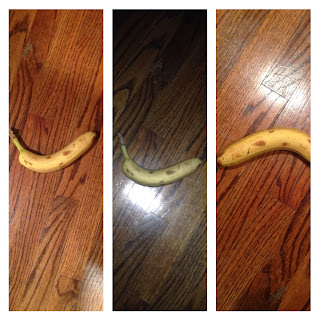Shape constancy which is also known as form constancy is a form of perceptual constancy where a familiar object keeps its perceived shape despite major changes in retinal stimulation due to changes in its orientation. The photo below shows two different views of an orange yet we can see that it is the exact same size.
Psych Blog
Wednesday, November 6, 2013
Brightness Constancy
Brightness constancy is when we observe that an object emits the same amount of light even when the light around the object differs. The photo shows three different photos of a banana under different lighting conditions but we can tell that the banana is still the same exact brightness.
Size Constancy
Size constancy is an aspect of perceptual constancy in which an object will appear to be the same size to an observer despite of changes in light , rotation, distance, perspective. The photo below is an example of size constancy because no matter what angle the photo is taken the glove still looks the same exact size.
Monocular Cue # 2
This is the second example of a monocular cue. We can tell that the lights are getting farther and farther away because they begin to narrow this is another great example of a monocular cue.
Monocular Cue #1 and Definition
Monocular cues provide depth information when viewing a scene with one eye. An example of this would be the picture shown below. We can tell that the one shoe is farther away than the other because the one to the right looks smaller than the other and our mind sees that as it being farther away, which it is.
Tuesday, November 5, 2013
Motion Perception
Motion perception is the process of inferring speed and direction of elements in a scene based on visual, vestibular and proprioceptive inputs. An example of this would be the picture seen below.
Binocular Cue
Subscribe to:
Comments (Atom)
.JPG)

.JPG)
.JPG)
.JPG)
